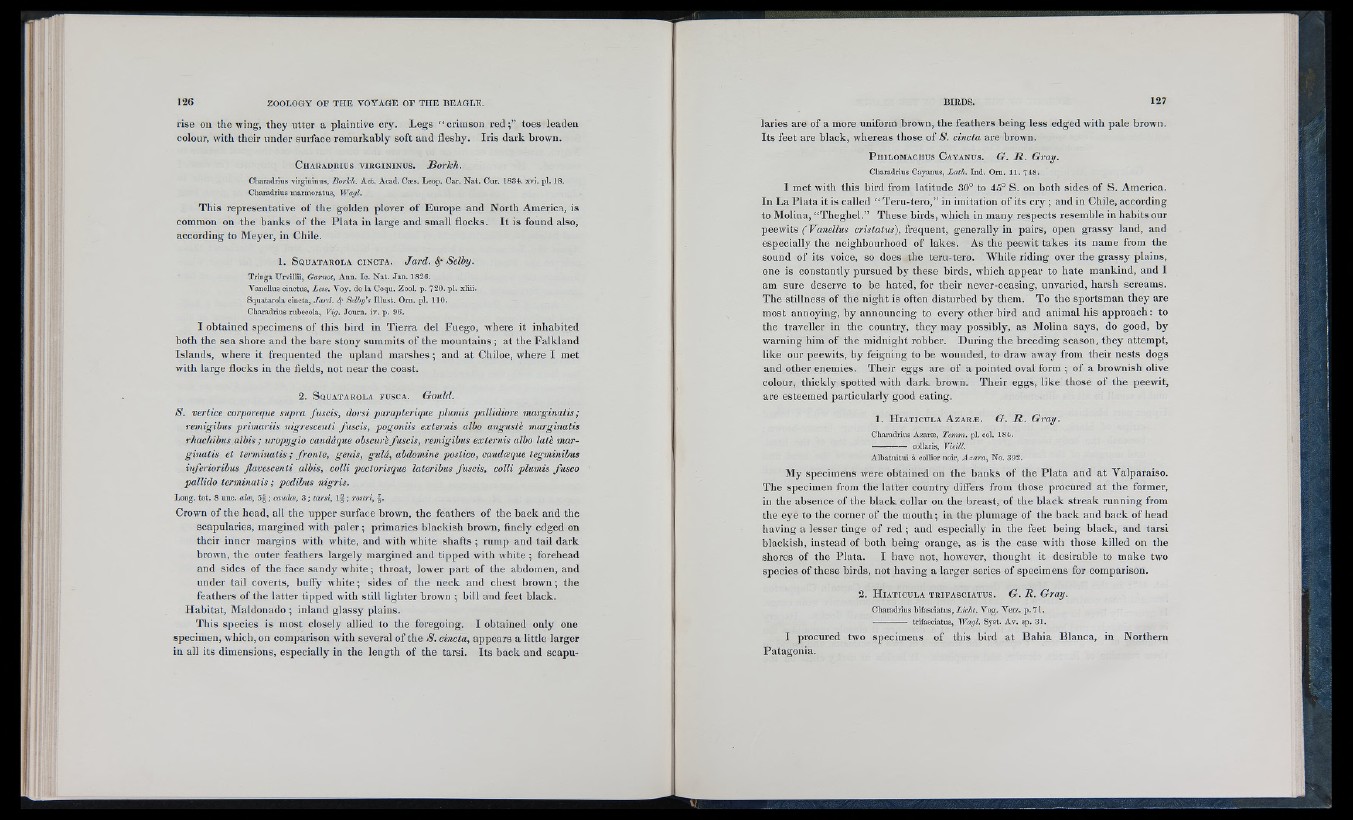
rise on the wing, they utter a plaintive cry. Legs “ crimson red toes leaden
colour, with their under surface remarkably soft and fleshy. Iris dark brown.
C h a r a d r iu s v i r g i n i n u s . Borkh.
Ch.aradrius virgininus, Borkh. Act. Acad. Cæs. Leop. Car. Nat. Cur. 1834. xvi. pl. 18.
Charadrius niarnioratus, Wagl.
This representative of the golden plover of Europe and North America, is
common on the banks of the Plata in large and small flocks. It is found also,
according to Meyer, in Chile.
1 . S q u a t a r o l a c i n c t a . Jard. ^ Selby.
Tringa TJrvillii, Gamot, Ann. Ic. Nat. Jan. 1826.
Vanellus cinctus. Less. Y o y. de la Coqu. Zool. p. 720. pl. xliii.
Squatarola cincta, Jard. 4' Selby's Illust. Orn. pl. 110.
Charadrius rubecola, Vig. Journ. iv. p. 96.
I obtained specimens of this bird in Tierra del Fuego, where it inhabited
both the sea shore and the bare stony summits of the mountains ; at the Falkland
Islands, where it frequented the upland marshes ; and at Chiloe, where I met
with large flocks in the fields, not near the coast.
2 . S q u a t a r o l a f u s c a . Gould.
S. vertice corporeque supra fuscis, dorsi parapterique plumis pallidiore marginatis ;
remigibus primariis nigrescenti fuscis, pogoniis externis albo aìigusth marginatis
rhachibus albis ; uropygio caudâque obscurè fuscis, remigibus externis albo latè marginatis
et terminatis ; fronte, genis, gulâ, abdomine postico, caudoeque tegminibus
inferioribus fiavescenti albis, colli pectorisque lateribus fuscis, colli plumis fusco
pallido terminatis ; pedibus nigris.
Long. tot. 8 unc. alee, 5 | ; caudæ, 3 ; tarsi, i f j rostri,
Crown of the head, all the upper surface brown, the feathers of the back and the
scapularies, margined witli paler; primaries blackish brown, finely edged on
their inner margins with white, and with white shafts ; rump and tail dark
brown, the outer feathers largely margined and tipped with white ; forehead
and sides of the face sandy white; throat, lower part of the abdomen, and
under tail coverts, buffy white ; sides of the neck and chest brown ; the
feathers of the latter tipped with still lighter brown ; bill and feet black.
Habitat, Maldonado ; inland glassy plains.
This species is most closely allied to the foregoing. I obtained only one
specimen, which, on comparison with several of the S. ciucia, appears a little larger
in all its dimensions, especially in the length of the tarsi. Its back and scapularies
are of a more uniform brown, the feathers being less edged with pale brown.
Its feet are black, whereas those of S. cincta are brown.
P h il o m a c h u s C a y a n u s . G. R . Gray.
Charadrius Cayanus, Lath. Ind. Orn. 11. 748.
I met with this bird from latitude 30° to 45° S. on both sides of S. America.
In La Plata it is called “ Teru-tero,” in imitation of its cry ; and in Chile, according
to Molina, “Theghel.” These birds, which in many respects resemble in habits our
peewits (Vanellus cristatus), frequent, generally in pairs, open grassy land, and
especially the neighbourhood of lakes. As the peewit takes its name from the
sound of its voice, so does the teru-tero. While riding over the grassy plains,
one is constantly pursued by these birds, which appear to hate mankind, and I
am sure deserve to be hated, for their never-ceasing, unvaried, harsh screams.
The stillness of the night is often disturbed by them. To the sportsman they are
most annoying, by announcing to every other bird and animal his approach: to
the traveller in the country, they may possibly, as Molina says, do good, by
warning him of the midnight robber. During the breeding season, they attempt,
like our peewits, by feigning to be wounded, to draw away from their nests dogs
and other enemies. Their eggs are of a pointed oval form ; of a brownish olive
colour, thickly spotted with dark brown. Their eggs, like those of the peewit,
are esteemed particularly good eating.
1 . H ia t i c u l a A z a r æ . G. R . Gray.
Charadrius Azaræ, Temm. pi. col. 184.
------------- collaris, Vieill.
Albatuitui à collier noir, A zara, No. 392.
My specimens were obtained on the banks of the Plata and at Valparaiso.
The specimen from the latter country differs from those procured at the former,
in the absence of the black collar on the breast, of the black streak running from
the eye to the corner of the mouth ; in the plumage of the back and back of head
having a lesser tinge of red ; and especially in the feet being black, and tarsi
blackish, instead of both being orange, as is the case with those killed on the
shores of the Plata. I have not, however, thought it desirable to make two
species of these birds, not having a larger series of specimens for comparison.
2 . H ia t ic u l a t r i f a s c i a t u s . G. R. Gray.
Charadrius bifasciatus, Licht. Vog. Verz. p. 71.
------------- trifasciatus, Wagl. Syst. Av. sp. 31.
I procured two specimens of this bird at Bahia Blanca, in Northern
Patagonia.